- Home Page
- Books
- Articles
- The Tribes
- Presentations
- Bonus Material
Ancient History Reconsidered


Neanderthal Nonsense!
Jack Cuozzo was an orthodontist who was one of the few people in the world to have had the opportunity to X-ray some of the Neanderthal skulls. The ones on display in the museums are only replicas. The real ones are locked safely away in vaults out of view of the public. What he uncovered, and reported in his book ‘Buried Alive’, is a story of fabrication and invention by palaeontologists and anthropologists in order to promote their arguments for an evolutionary link between man and apes. Dr Cuozzo even witnessed first hand a qualified anthropologist deliberately sawing off the chin from one of the human skulls to make the skull appear more ape-like. (Apes do not have chins.) In the course of his research he discovered other examples of this practice.
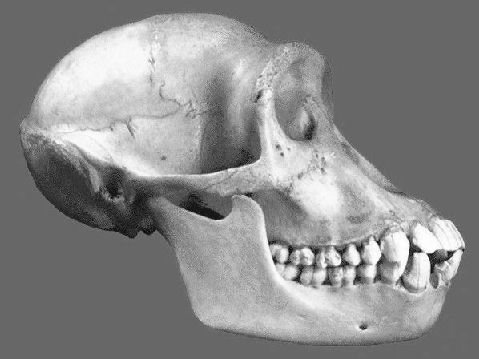
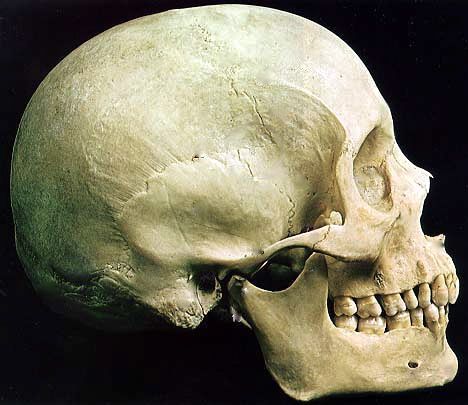
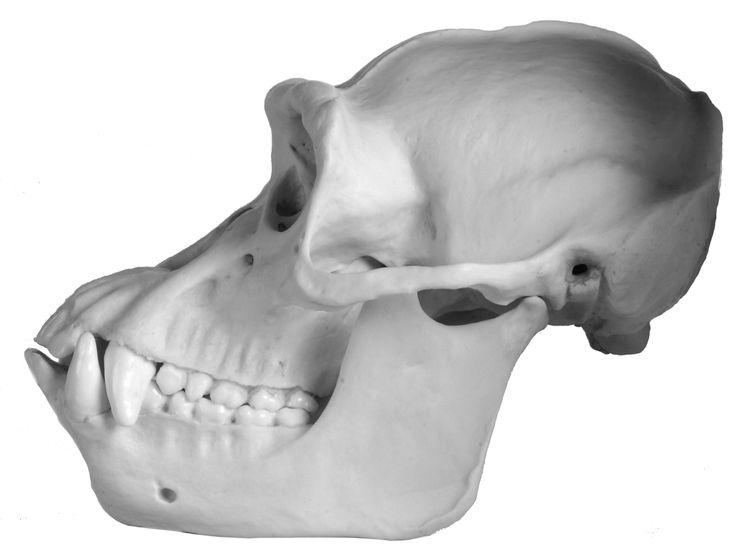
From left to right: Skull of chimpanzee, human and gorilla. Note that the human skull has a protruding chin, which chimpanzees and gorillas do not have.


Le Moustier skull from a souvenir slide supplied by the museum. Notice how the lower jaw is 30mm out of joint. The arrow shows where the back of the jaw is supposed to fit.
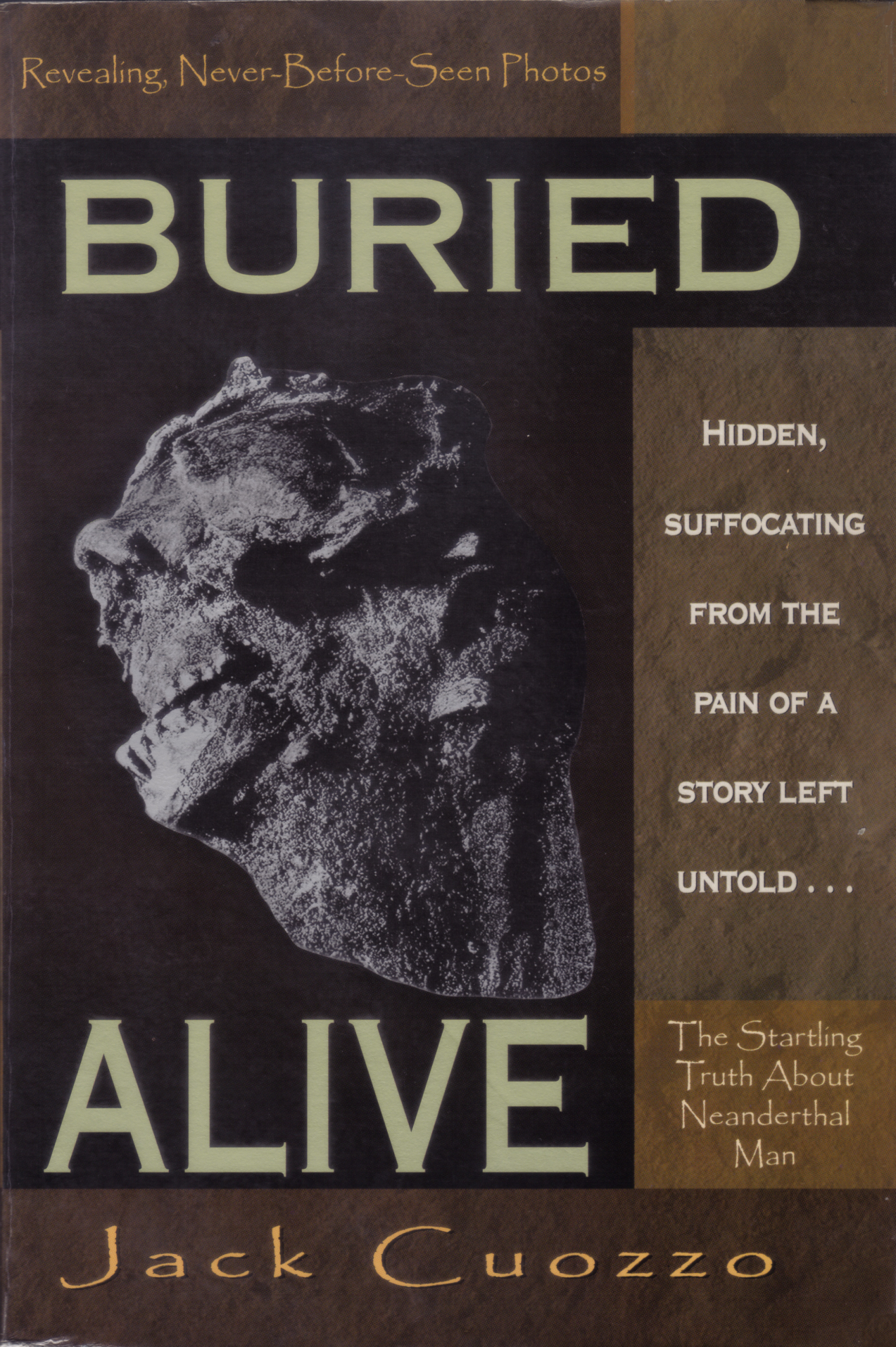
The cover of Jack Cuozzo’s book Buried Alive.
The skull known as Le Moustier, named after the small town of that name in the Dordogne in France, is presented to us as shown in the plate on the left. The arrow shows where the back of the lower jaw should connect. Anthropologists have deliberately moved the lower jaw forwards by 30mm in order to make it appear ape-like. On examining the teeth, Jack Cuozzo realised that they had deliberately arranged them in such a way to promote this ape-like appearance. Being a trained orthodontist, Jack Cuozzo was able to realign the teeth according to the occlusions (the way the teeth fit together) and after doing this, the skull no longer looked anything remotely like that of an ape!
In his book, Cuozzo produces sound scientific evidence to show that the Neanderthal skulls most likely belonged to people who lived to an older age than modern man, but they matured much later and aged much more slowly. This is actually in line with what the Bible teaches. We are told, for example, that Abraham’s wife Sarah was still attractive at the age of 95, so much so that Abimelech king of Gerar desired her and wanted her to be his wife. (Gen. 20:1-3) Abraham was 99 years old when Ishmael was circumcised (Gen. 17:24) and his wife Sarah was ten years younger than Abraham. (Gen. 17:17) Evolutionists are determined to prove that man has descended from apes, which is why we keep hearing in the news reports of the remains of the ‘earliest known hominim’ being found. There is a lot of kudos attached to proving that evolution occurred. New finds make headline news. When their claims are subsequently shown to be false and retracted, it never makes the headlines.
Cuozzo even presented evidence to show that children today are maturing faster than they did 100 years ago. Girls likewise are experiencing their first menstrual period at an earlier age than those recorded by Wyshak and Frisch in the late 1700s and early 1800s. Basically, this evidence supports the results of genetic research which shows that the number of DNA errors are increasing with each new generation, whether of man or of animals. In other words, everything is slowly dying. The technical term for this state of deterioration is genetic entropy.
These ‘Neanderthals’ were no different to any other humans. They used tools, body decoration and cosmetics, cooking utensils, buried their dead with ornaments, and in every other respect were ordinary humans. Anthropologists are simply applying fanciful interpretations to the skeletal remains, interpretations which have been challenged and are being shown to be false.
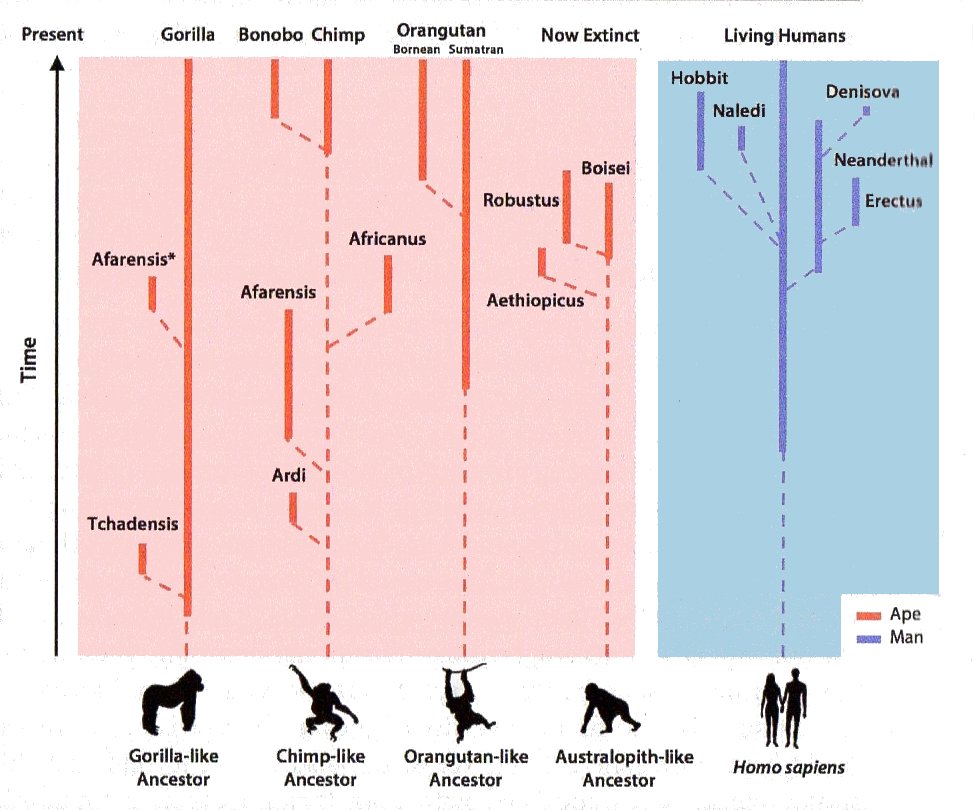
Chart from Rupe’s book Contested Bones showing the lack of connectivity between apes and humans. (Courtesy of Rupe and Sanford)
*Note that Afarensis appears
in both the gorilla and the chimp families. This is because anthropologists do not know in which family they belong.
Biologist Christopher Rupe has spent more than four years of intense research into the ape to man claims and has presented his findings in his book, which he has co-written with Dr. John Sanford. Anthropologists do not have one shred of evidence of ape to human evolution, and yet they present it as though it was a scientific fact. Some palaeontologist are actually starting to admit this, though instead of admitting that humans have not evolved from apes, they are simply saying that they need to ‘rethink’ their stance. They are so committed to their religiously held belief that evolution is the only explanation for the origin of life that they will always try and interpret things according to what they term a ‘naturalistic cause’. The suggestion that there is a God or that we were purposefully designed is to them anathema. They just will not go there! They will always try and shoehorn everything into their naturalistic interpretations. When you apply any bias such as this, you are ignoring science. A scientist has to consider all possibilities irrespective of whether or not they agree with that alternative interpretation. That is how science is supposed to be conducted, but they just won’t go there. The technical term for this biased interpretation of data is ‘Confirmation Bias’.
“For instance, more data makes it easier to find support for virtually any position — because more data provides more options, limited only by the creativity of the analyst. Analysis could choose to focus on a subset that shows the ‘correct’ results. Or, data that counters a desired position could be filtered out as ‘erroneous.’ Sophisticated tools support many different modeling methods and options; one is bound to find the ‘right’ answer. Just keep adding and dropping variables or observations until the known ‘truth’ shines through.
“Using data and analytics to support pre-existing beliefs is called ‘confirmation bias.’ This is a particularly acute problem for modern analytics due to the potent combination of access to massive amounts of data, sophisticated methods and the seeming irreproachability of data-based decisions.
“Confirmation bias can advance personal and political agendas or technical outcomes in ways that are difficult to detect. It can take the form of looking only for evidence that supports a desired outcome.” (Better Decision Making with Objective Data is Impossible by Sam Ransbotham, 28 Jul 2015. https://sloanreview.mit.edu/article/for-better-decision-making-look-at-facts-not-data/.)
Rupe comments:
“The paleo-community openly acknowledges that [the] hominin fossil record (the actual data) does not reflect an ape-to-man progression. Instead, there appears to be a clear separation between the ape and human type. There is a lot of diversity within the ape type and a lot of diversity within the human type (with many variants now extinct). There is also branching within each group. Yet we are not seeing a fossil trail connecting these two very distinct groups (ape and man) via a series of intermediate forms, A more accurate representation of the data is with multiple branching trees (reflecting adaptive radiation over time), rather than a single tree with single common ancestor of ape and man.” Contested Bones p.342 (fig. 3), Christopher Rupe and Dr. John Sanford, FMS Publications, 2019. (ISBN: 9780981631677)
Evolutionists will always talk in terms of hundreds of thousands of years for the appearance of the first hominids, using the fossil record as ‘evidence’. You will often find them talking of Neanderthal remains dating from as early as 600,000 bce and they keep trying to push that date back even further. It should be stressed that they have no reliable method of dating which can confirm these dates. (Note that every single method of radiometric dating has been shown to be fundamentally flawed. For more information on this, see Chapter 1 of my main work Ancient History Reconsidered.) My own research actually shows that the regions in which the Neanderthal remains are being found were uninhabited by man prior to 400 bce. Their dates are wildly inaccurate, having been ‘pulled out of thin air’ From experience, I find that man will always push back history to some remote and obscure past thereby undermining the authority, not only of the Bible, but of all the written records left to us by the Greek and Latin writers as well.
The skull of the Broken Hill Man (also known as Homo Rhodesiensis or Rhodesian Man) found in Zambia and first described by Arthur Smith Woodward in 1921, is supposedly more than 100,000 years old. Jack Cuozzo examined the skull and discovered an 8mm diameter hole in the side. The bevel on the inside of the skull shows that it was caused by a high velocity projectile, the type of entry and exit wound one would expect from a gun shot firing an 8mm calibre bullet. There is even a similar exit hole on the other lower side of the skull at an angle which is consistent with a bullet passing through it.
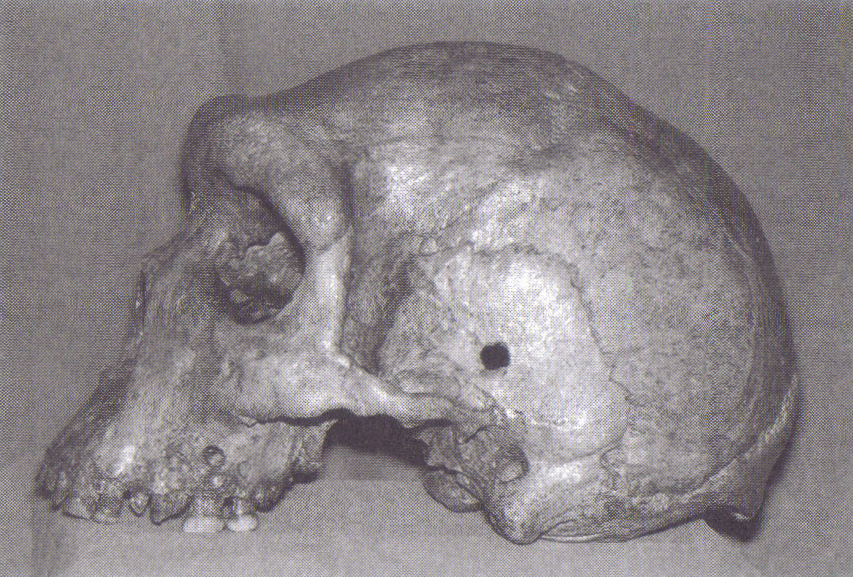
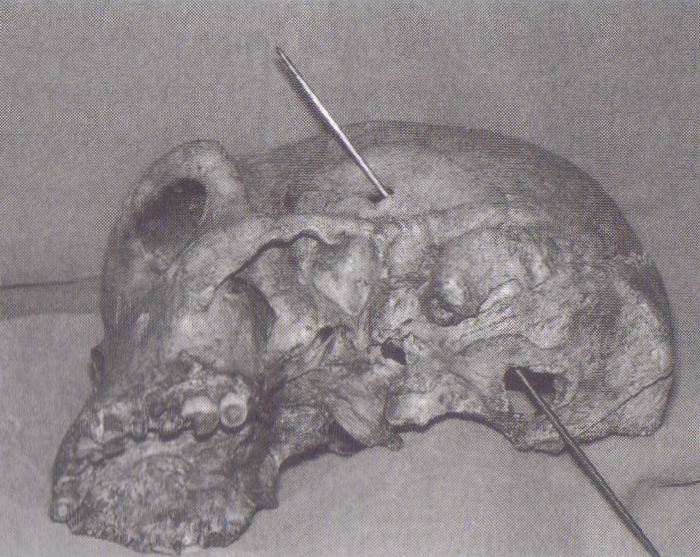
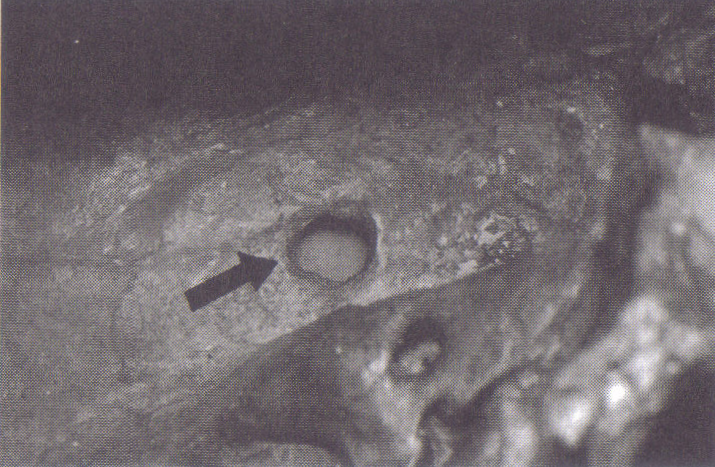
Left: Skull of Broken Hill Man showing bullet hole.
Centre: A rod passing through the entry and exit holes of the bullet.
Right: The inside of the skull showing the entrance wound, which exhibits the type of damage one would typically expect from a high velocity projectile such as a bullet.
According to the scientific tests performed on this skull, it is supposed to be around 100,000 to 200,000 years old!
Let us just clarify that, if the bullet hole was made post-mortem, then the skull would have just shattered. Alternatively, had the skull been embedded in soil, then the bullet would not have penetrated through the soil to make an exit wound. The only logical explanation for this wound is if it occurred when the man was still alive and was the cause of his death. Bear in mind that this skull was found in a mine 60ft underground, which rules out any suggestion that someone may have used the skull for target practice. But if the skull has a bullet hole through it, then there is no way that it can possibly be a thousand years old, let alone 100,000 years! Recent research shows that radiocarbon dating and the other methods of dating in which archaeologists are putting so much misplaced trust are seriously flawed, but man cannot let go of this idea of the extreme antiquity of the human race.
Dated 6 May 2024.
©AHR Researches.